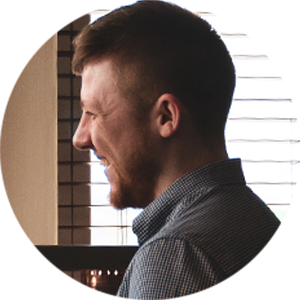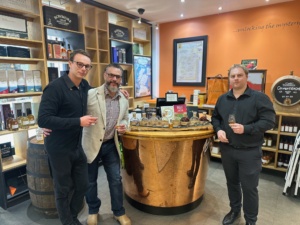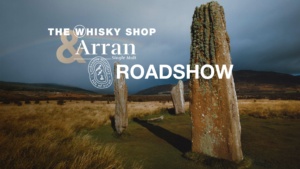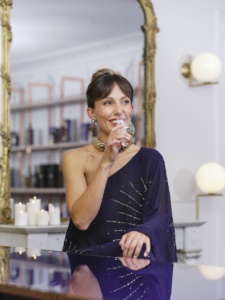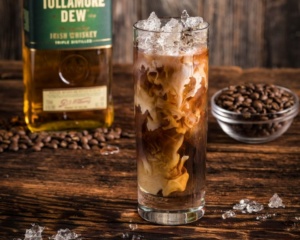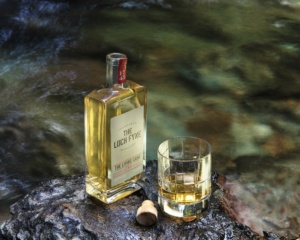My Craft | Glencairn
This winter we’ve been lucky enough to get a look behind the scenes at Glencairn Crystal, creators of the world’s finest bespoke decanters and the famous Glencairn whisky tasting glass.
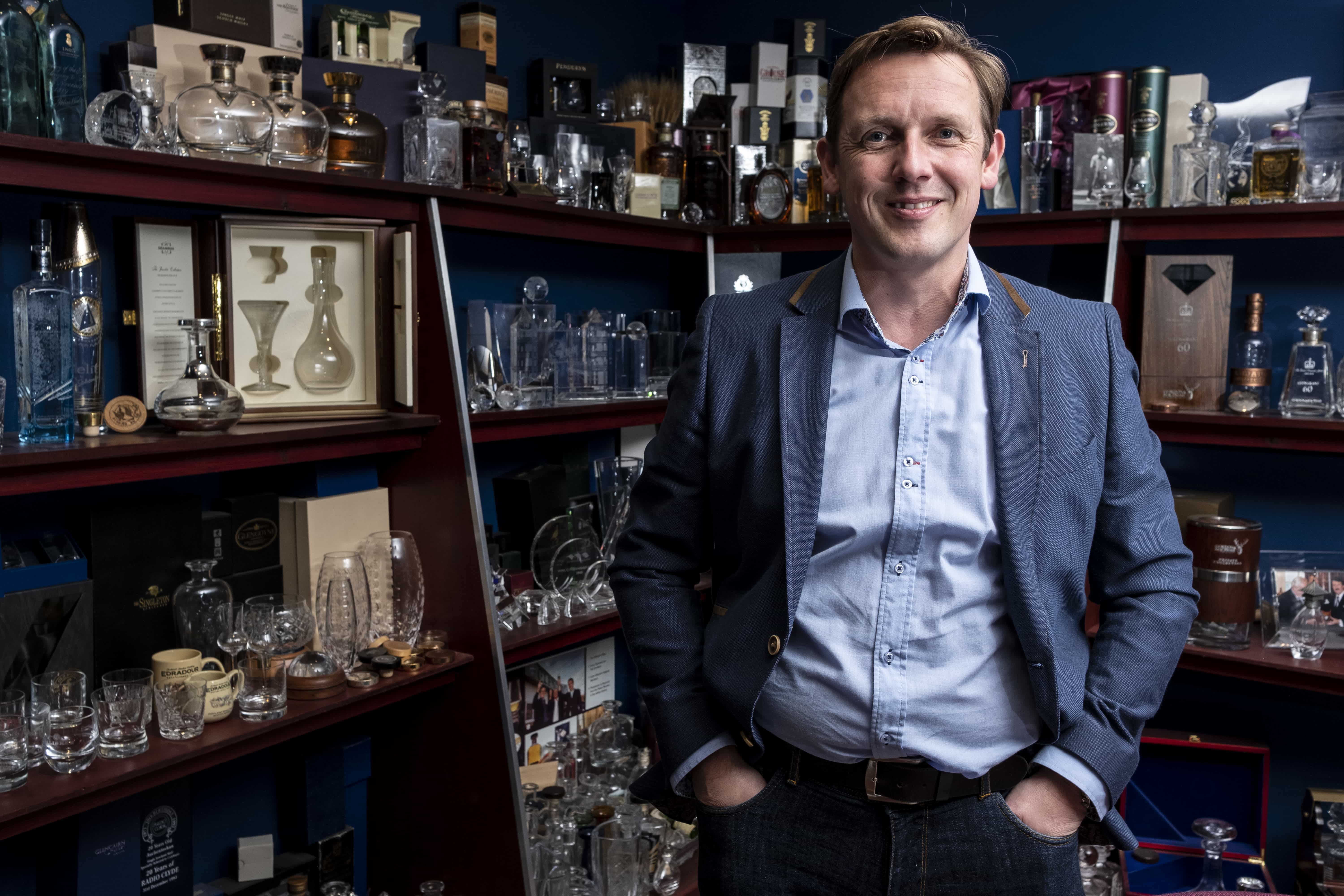 Scott Davidson, new product development director and son of Raymond, Glencairn’s founder, showed us around…
How long have you been part of the Glencairn Crystal operation?
I’ve been engraving crystal since I was 14, since my dad said “Here’s a good idea! Can you help me do this?”.
I studied computer science and electronics at the University of Strathclyde and all my classmates went into computer jobs and electronics. I stayed in the family business. On a Wednesday afternoon when everyone else was doing sports, I was doing accounting courses or working weekends, engraving decanters and the rest of it. That’s how I grew up.
What I’ve learned is that when your father starts a business, it’s just him keeping the whole thing going. But then with Paul (my brother) and I in the business, he had help, so he could start to scale things. That’s what we’ve been doing over the last 25 to 30 years since we joined, looking for opportunities to grow. Paul was always focused on sales, and both of us have spent time running the whole operation, but for the last 10 to 15 years he’s been running it and I’ve been on product design.
Scott Davidson, new product development director and son of Raymond, Glencairn’s founder, showed us around…
How long have you been part of the Glencairn Crystal operation?
I’ve been engraving crystal since I was 14, since my dad said “Here’s a good idea! Can you help me do this?”.
I studied computer science and electronics at the University of Strathclyde and all my classmates went into computer jobs and electronics. I stayed in the family business. On a Wednesday afternoon when everyone else was doing sports, I was doing accounting courses or working weekends, engraving decanters and the rest of it. That’s how I grew up.
What I’ve learned is that when your father starts a business, it’s just him keeping the whole thing going. But then with Paul (my brother) and I in the business, he had help, so he could start to scale things. That’s what we’ve been doing over the last 25 to 30 years since we joined, looking for opportunities to grow. Paul was always focused on sales, and both of us have spent time running the whole operation, but for the last 10 to 15 years he’s been running it and I’ve been on product design.
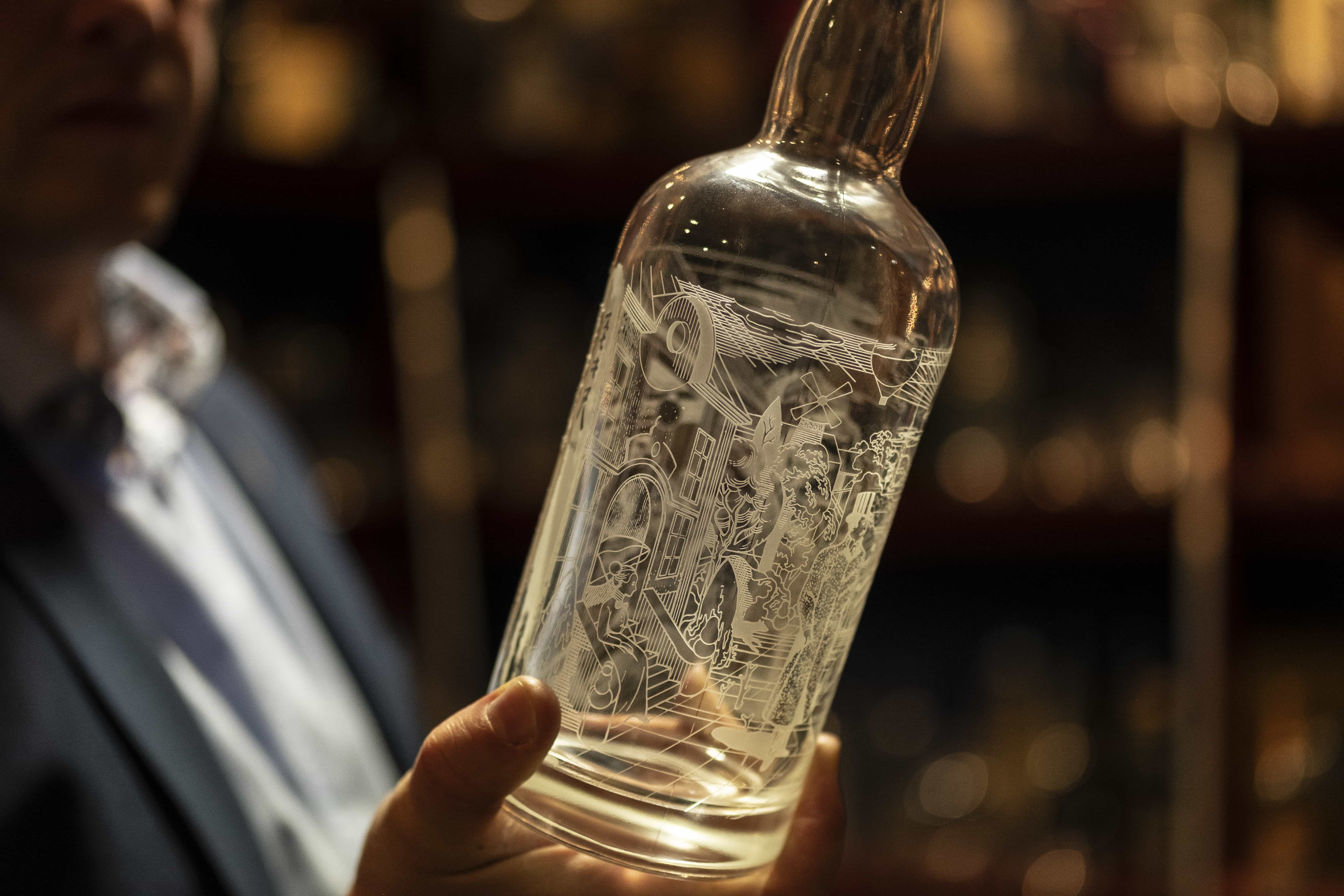 How did it all begin?
My dad was ex-Edinburgh Crystal. He was brought in to set up their engraving division, but they folded it after a few months because they were too busy making standard cut crystal for the retail market and they couldn’t service their engraving customers. So, my dad said “I’m going do this myself, I think there’s a longevity in this”.
How do you approach your product development?
We have to balance achieving an aesthetic specification, while trying to meet a technical specification. We’ve got to make sure each decanter is bulletproof! If any of the decoration comes off, it will fail the product test and it won’t be sellable.
Also, all these things are time sensitive, so we’re always up against the clock.
Do you help with the initial design work, or come up with designs from scratch?
We almost always have to be involved in creating the design, or redesign what we are given, because sometimes designers come up with concepts and then we have to say “We can’t physically achieve that”. Then you’ve got to redo the artwork, and go back to the customer and explain what’s possible and why.
How often is it that a client or brand comes to you with a completely outlandish design, and you have to find a way to do it?
All the time, and we relish trying to challenge ourselves! There are some ideas we have to turn away, because we only believe in engineering things to their best. The designs have got to fit on different substrates – you’re mixing glass with metals that’re made in different ways with different variables. Some things work, some things don’t.
We’re constantly working to find how to get the best out of a product, and the really stressful thing is trying to get the best out of a product that only has a very limited run.
People will ask us to do stuff that’s never been done before. So we’re being asked to push the boundaries on what’s feasible, and we encounter problems on the way. But, after you’ve done it, you have to say “Well that’s that finished now, onto the next one!” and it’s onto something completely different. And that’s the beauty and the joy of it.
How did it all begin?
My dad was ex-Edinburgh Crystal. He was brought in to set up their engraving division, but they folded it after a few months because they were too busy making standard cut crystal for the retail market and they couldn’t service their engraving customers. So, my dad said “I’m going do this myself, I think there’s a longevity in this”.
How do you approach your product development?
We have to balance achieving an aesthetic specification, while trying to meet a technical specification. We’ve got to make sure each decanter is bulletproof! If any of the decoration comes off, it will fail the product test and it won’t be sellable.
Also, all these things are time sensitive, so we’re always up against the clock.
Do you help with the initial design work, or come up with designs from scratch?
We almost always have to be involved in creating the design, or redesign what we are given, because sometimes designers come up with concepts and then we have to say “We can’t physically achieve that”. Then you’ve got to redo the artwork, and go back to the customer and explain what’s possible and why.
How often is it that a client or brand comes to you with a completely outlandish design, and you have to find a way to do it?
All the time, and we relish trying to challenge ourselves! There are some ideas we have to turn away, because we only believe in engineering things to their best. The designs have got to fit on different substrates – you’re mixing glass with metals that’re made in different ways with different variables. Some things work, some things don’t.
We’re constantly working to find how to get the best out of a product, and the really stressful thing is trying to get the best out of a product that only has a very limited run.
People will ask us to do stuff that’s never been done before. So we’re being asked to push the boundaries on what’s feasible, and we encounter problems on the way. But, after you’ve done it, you have to say “Well that’s that finished now, onto the next one!” and it’s onto something completely different. And that’s the beauty and the joy of it.
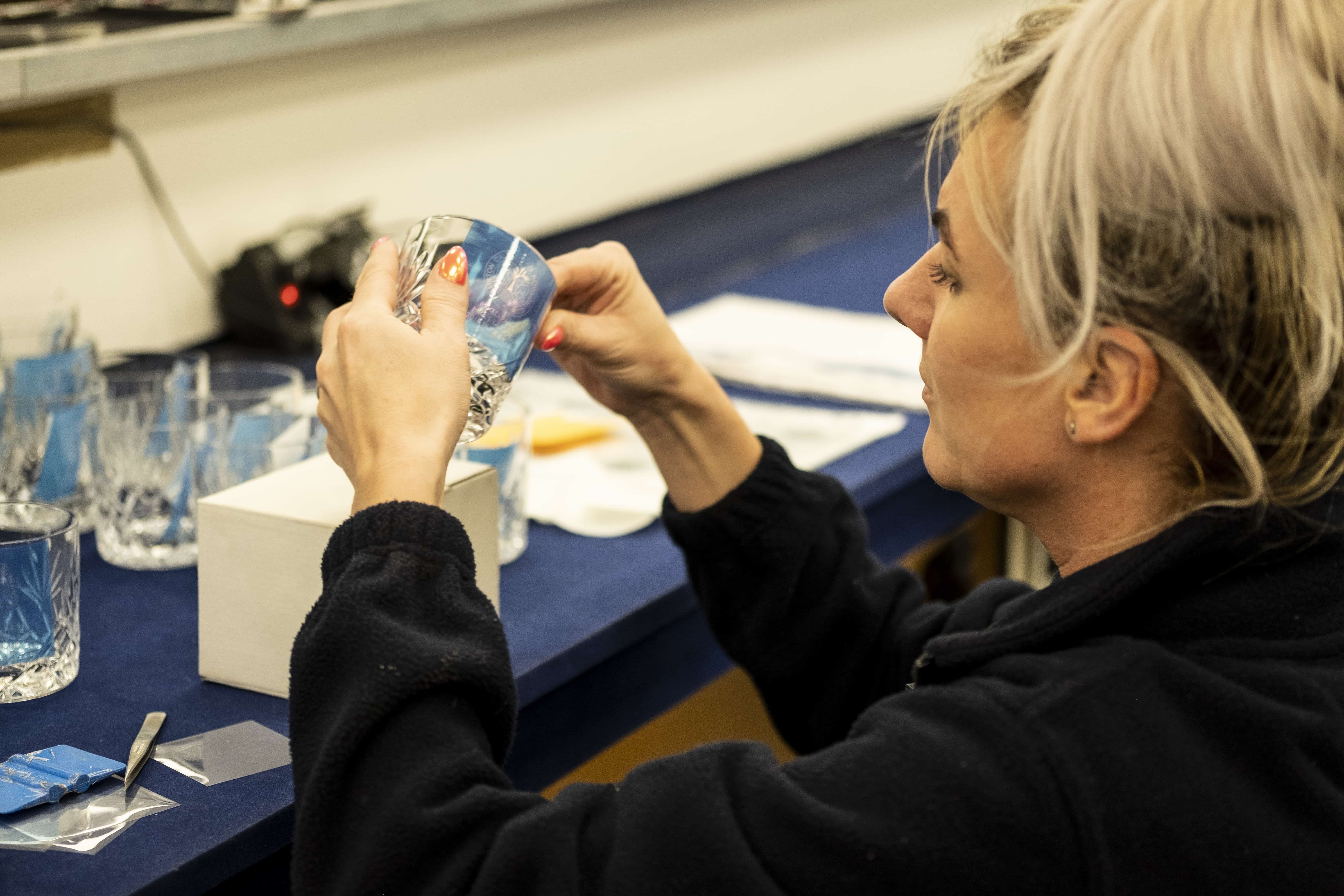 Do you have a favourite design you’ve developed, or worked on, or a favourite challenge you’ve risen to?
This really is a bit of a Sophie’s Choice question! We love all our work but cracking the really difficult ones is always a bonus.
We did a Dewar’s Legacy decanter and it’s got this metal part, based on a sort of dirk (dagger) attached to it, that had to pour through the metal. That was really quite challenging, to co-ordinate, while staying true to the designer’s original concept, and actually make it feasible.
We were also asked to do a Royal Brackla 35 Year Old, which you can see in Duty Free right now. It’s a sphere, suspended on five points – we had a 5mm triangle as the gluing area, so we had to develop an adhesive that could withstand a drop test that would survive, without splitting, from a metre high. And we knew it was the right adhesive when the glass broke, but was left stuck to each point – at £1000 per test!
People want us to meet all these mad capabilities, but also have something that looks utterly fantastic when it’s put on the table.
That in itself is a journey.
How do you manage expectations with bottle designs becoming more and more intricate?
We like to talk to people, discuss the design. We’ll say “If you talk to us we can tell you what’s actually do-able, what’s actually producible, what physically can be achieved.’ Just to use as guidelines, as this will help instruct their design”.
Because we would rather the build works in a straight-forward manner, so we can filter out all the things that aren’t feasible, and amend some of the non-workable creative elements and eliminate all the errors, before the design is done. We can help designers work their way through it so it gets accepted by the client.
Do you have a favourite design you’ve developed, or worked on, or a favourite challenge you’ve risen to?
This really is a bit of a Sophie’s Choice question! We love all our work but cracking the really difficult ones is always a bonus.
We did a Dewar’s Legacy decanter and it’s got this metal part, based on a sort of dirk (dagger) attached to it, that had to pour through the metal. That was really quite challenging, to co-ordinate, while staying true to the designer’s original concept, and actually make it feasible.
We were also asked to do a Royal Brackla 35 Year Old, which you can see in Duty Free right now. It’s a sphere, suspended on five points – we had a 5mm triangle as the gluing area, so we had to develop an adhesive that could withstand a drop test that would survive, without splitting, from a metre high. And we knew it was the right adhesive when the glass broke, but was left stuck to each point – at £1000 per test!
People want us to meet all these mad capabilities, but also have something that looks utterly fantastic when it’s put on the table.
That in itself is a journey.
How do you manage expectations with bottle designs becoming more and more intricate?
We like to talk to people, discuss the design. We’ll say “If you talk to us we can tell you what’s actually do-able, what’s actually producible, what physically can be achieved.’ Just to use as guidelines, as this will help instruct their design”.
Because we would rather the build works in a straight-forward manner, so we can filter out all the things that aren’t feasible, and amend some of the non-workable creative elements and eliminate all the errors, before the design is done. We can help designers work their way through it so it gets accepted by the client.
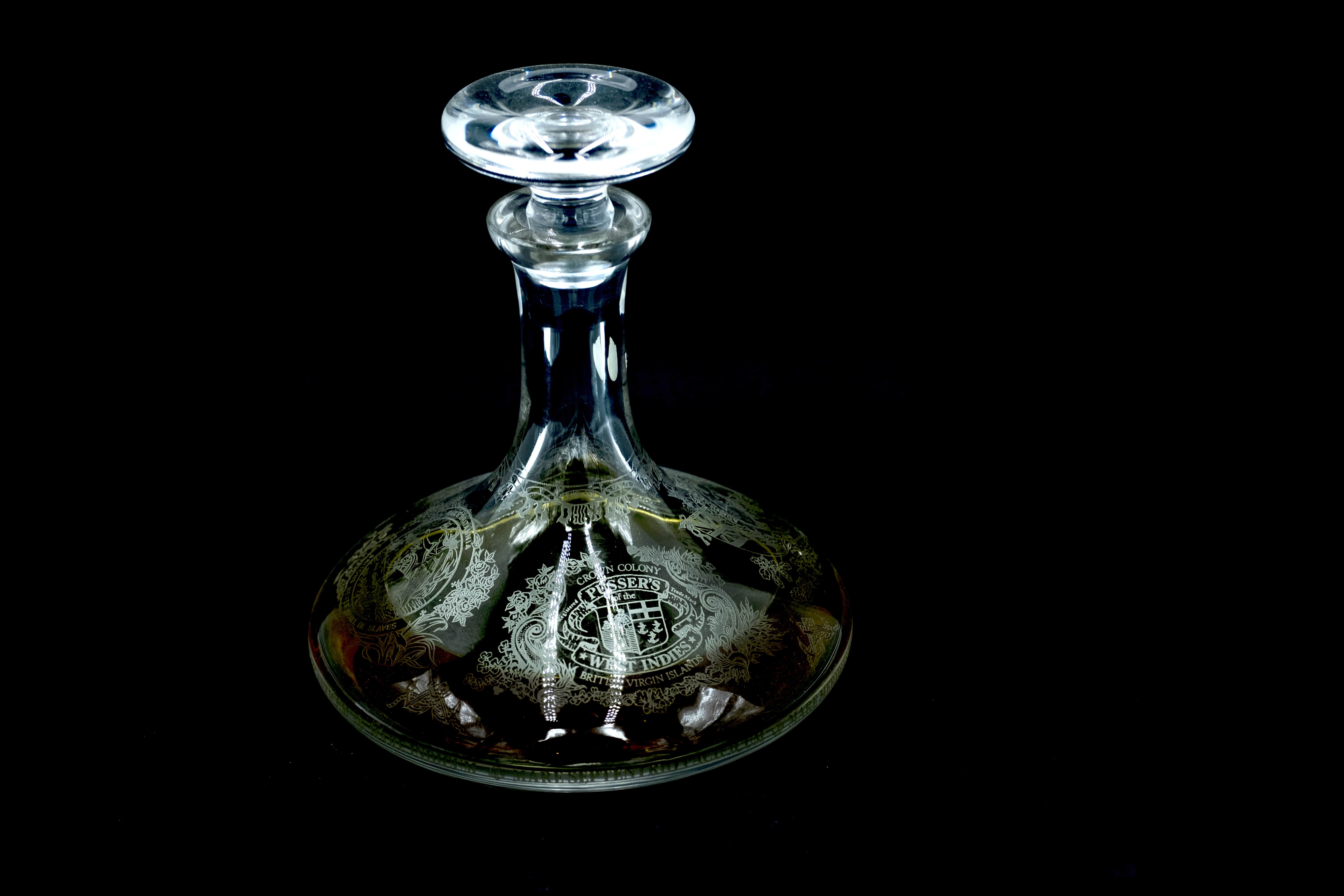 There’s a beautiful tradition of craft linked to whisky, but also a trend for brands to innovate and be ‘different’. How does that impact what you do here?
We’re in the middle of it, with all of the customers coming to us saying “Here’s my really unique design”, and we know about products and can say, “No, that’s been done before”. You get a lot of ‘new blood’ coming in and they bring out something like a square and say “This is the future”, but you go back a decade and for 200 years before that people have been using a square decanter quite successfully to represent whisky in a bottle!
Are there ever really any ‘new ideas’?
There’s no new ideas, but one great thing about the drinks industry right now – talking from a crystal maker’s point of view – is that what’s being created is a new wave of product development and innovation for the glass industry. Because they’ve actually got budget to invest in malts, and to invest in new techniques, trying things to make their products look fantastic. And that itself is magical.
One of the great things about crystal is that you can do so many things with it. An attractive quality of crystal, that gets overlooked all the time, is the ability for it to achieve that refraction of light that throws out rainbow and colour, and when you put anything in it, it gives the product within a unique sparkle. A lot of glassmakers, especially those who produce high volumes of glass, try to recreate these features. But it’s only when you do it by hand that you see the quality.
Do you believe presenting a product in crystal increases its perceived value?
I think it’s part of the full package now. It used to be that a crystal decanter was used as a flag flying exercise, just for brands to say “We do really nice things now and again”, but we’ve actually found a way to engineer decanters into the luxury market scene.
People are seeing a real return for this added value packaging. People who order a very expensive bottle with a very expensive process for the ‘label’ – in our case, a process which is all done by hand – expect more. Companies now just refer to these [decanters] as ‘containers’. They’re containers for that particular age of spirit. There’s almost an evolution, where people have decided that if they want to compete in the World’s Duty Free market, and want to be the choice over that Rolex, or that very expensive handbag, that Glencairn have a solution that can give them that offering.
And the thing is, compared to the luxury watch or handbag, their bottle of whisky might be number 22 of only 250. It’s got a genuine limited-edition factor.
There’s a beautiful tradition of craft linked to whisky, but also a trend for brands to innovate and be ‘different’. How does that impact what you do here?
We’re in the middle of it, with all of the customers coming to us saying “Here’s my really unique design”, and we know about products and can say, “No, that’s been done before”. You get a lot of ‘new blood’ coming in and they bring out something like a square and say “This is the future”, but you go back a decade and for 200 years before that people have been using a square decanter quite successfully to represent whisky in a bottle!
Are there ever really any ‘new ideas’?
There’s no new ideas, but one great thing about the drinks industry right now – talking from a crystal maker’s point of view – is that what’s being created is a new wave of product development and innovation for the glass industry. Because they’ve actually got budget to invest in malts, and to invest in new techniques, trying things to make their products look fantastic. And that itself is magical.
One of the great things about crystal is that you can do so many things with it. An attractive quality of crystal, that gets overlooked all the time, is the ability for it to achieve that refraction of light that throws out rainbow and colour, and when you put anything in it, it gives the product within a unique sparkle. A lot of glassmakers, especially those who produce high volumes of glass, try to recreate these features. But it’s only when you do it by hand that you see the quality.
Do you believe presenting a product in crystal increases its perceived value?
I think it’s part of the full package now. It used to be that a crystal decanter was used as a flag flying exercise, just for brands to say “We do really nice things now and again”, but we’ve actually found a way to engineer decanters into the luxury market scene.
People are seeing a real return for this added value packaging. People who order a very expensive bottle with a very expensive process for the ‘label’ – in our case, a process which is all done by hand – expect more. Companies now just refer to these [decanters] as ‘containers’. They’re containers for that particular age of spirit. There’s almost an evolution, where people have decided that if they want to compete in the World’s Duty Free market, and want to be the choice over that Rolex, or that very expensive handbag, that Glencairn have a solution that can give them that offering.
And the thing is, compared to the luxury watch or handbag, their bottle of whisky might be number 22 of only 250. It’s got a genuine limited-edition factor.
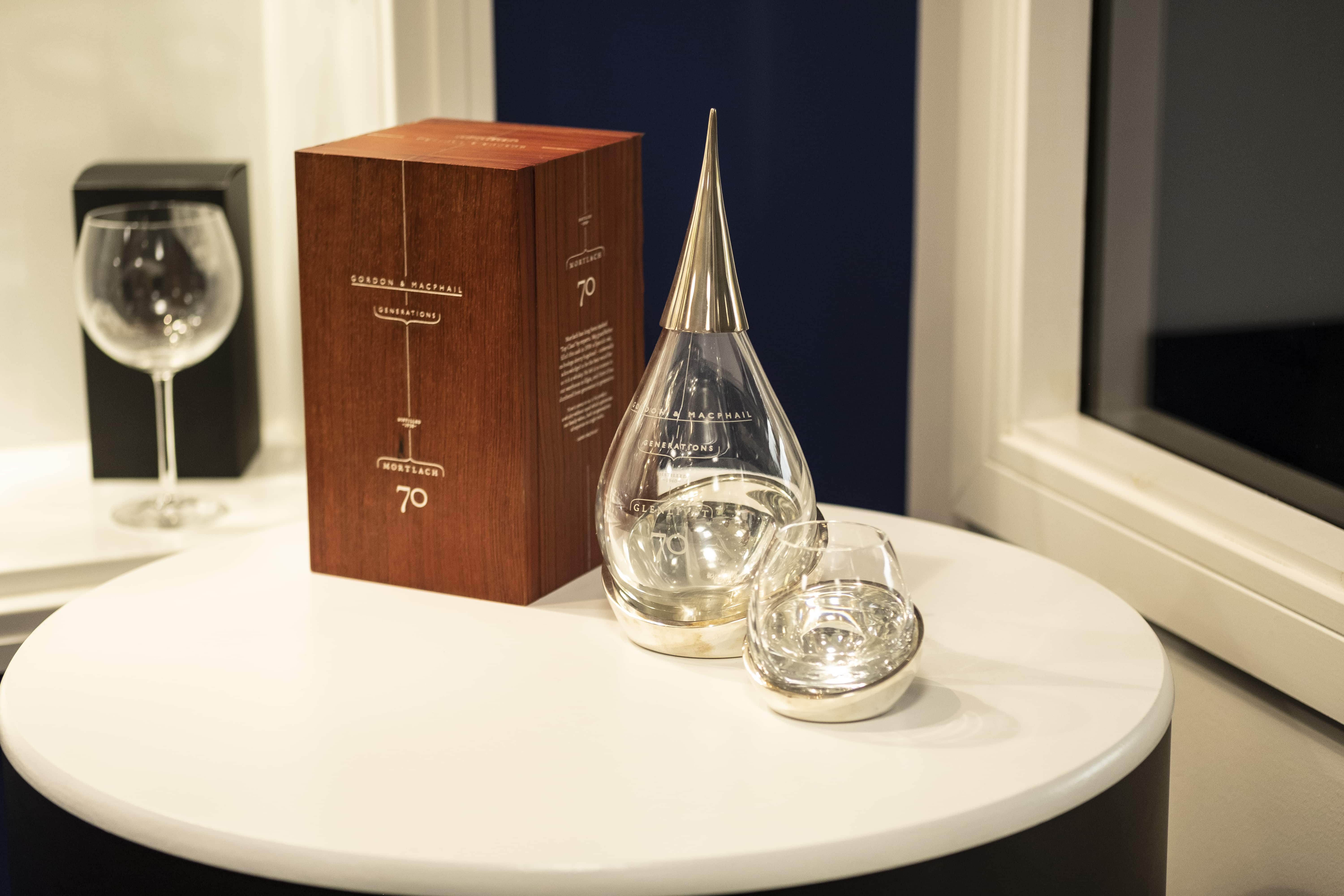 We see the bottle for the upcoming Littlemill 40 Year Old. How much would that decanter cost to make?
A few hundred pounds per bottle! The product itself is so rare – a 40 year old whisky – that you’re saying that the rarity of these products, combined with the added value of the packaging, positions it in a completely different marketplace.
The great thing is, our business is geared towards that shift in the industry. We want to be doing small-to-mid volume and some product runs that go towards the thousands, but we enjoy diversity.
As a business you can see the diversity in our factory. Our other business services all sorts of gifting and corporate events – but the drinks industry, and containers, is taking up more and more of our lives.
Why do you think you gained the monopoly on crafting containers for the whisky companies?
Probably because we are from Airdrie originally. The big whisky companies in Airdrie at the time were Inverhouse, Burn Stewart and, in front of Albion Rovers was William Lawson’s. So my dad (founder of Glencairn Crystal Raymond Davidson) grew up around that, and that’s how he reached out and got hooked into the industry. We have always positioned ourselves as a company that enhances the whisky companies’ products. We take a real interest in the industry and supply products and processes that are of value to the marketplace.
When did you come to realise that you are the biggest player in the crystal engraving market?
There are only two manufacturers of the special film that produce stencils for the engraving marketplace, and one is based in California. About five years ago they said they’d like to come over and visit, they wanted us to represent them as a distributor because they thought we were distributing the special film around the marketplace, we were buying that much – more than anyone else. And we said, “We don’t distribute it! Everything you send us, we’re using to create our own products!”. It came as a surprise to them, as it did to us.
We see the bottle for the upcoming Littlemill 40 Year Old. How much would that decanter cost to make?
A few hundred pounds per bottle! The product itself is so rare – a 40 year old whisky – that you’re saying that the rarity of these products, combined with the added value of the packaging, positions it in a completely different marketplace.
The great thing is, our business is geared towards that shift in the industry. We want to be doing small-to-mid volume and some product runs that go towards the thousands, but we enjoy diversity.
As a business you can see the diversity in our factory. Our other business services all sorts of gifting and corporate events – but the drinks industry, and containers, is taking up more and more of our lives.
Why do you think you gained the monopoly on crafting containers for the whisky companies?
Probably because we are from Airdrie originally. The big whisky companies in Airdrie at the time were Inverhouse, Burn Stewart and, in front of Albion Rovers was William Lawson’s. So my dad (founder of Glencairn Crystal Raymond Davidson) grew up around that, and that’s how he reached out and got hooked into the industry. We have always positioned ourselves as a company that enhances the whisky companies’ products. We take a real interest in the industry and supply products and processes that are of value to the marketplace.
When did you come to realise that you are the biggest player in the crystal engraving market?
There are only two manufacturers of the special film that produce stencils for the engraving marketplace, and one is based in California. About five years ago they said they’d like to come over and visit, they wanted us to represent them as a distributor because they thought we were distributing the special film around the marketplace, we were buying that much – more than anyone else. And we said, “We don’t distribute it! Everything you send us, we’re using to create our own products!”. It came as a surprise to them, as it did to us.
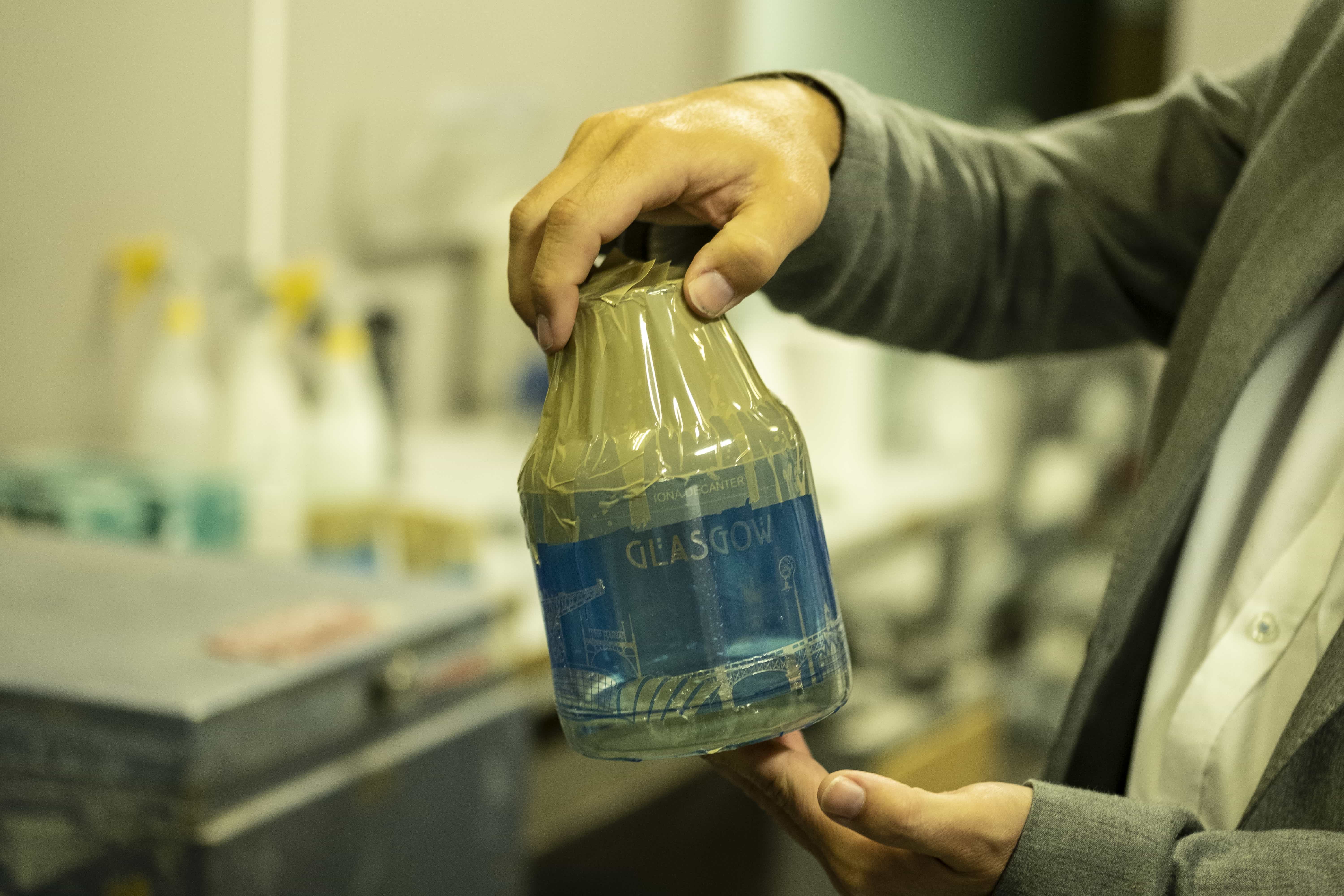 How has the process evolved?
The whole process used to be based around a fine tissue, and you would screen print rubberised ink onto the tissue, then glue that onto the glass. If it curved in two planes, it was a nightmare. Then you’d sandblast it. And if you had any deposit thickness you had to engrave through that glue! It was OK doing it once but in those days if you do it a hundred times it was challenging. Now we’ve got over 20 people here and that’s all they do, and we’ve got a very refined process for doing it.
By and large, the engraving process I developed when I ended up full-time in the business, six years after first starting and after uni, was the process we started adopting all the time.
We also now have a special team here who figure out all the metal work and how we make it meet all the criteria – because everything has to meet all the food use, quality and visual standards.
It’s one of those crazy things, the journey we’ve been on – all the processes we learned, all the ideas and ways of making it easier for ourselves to brand and decorate, are what’s got us to where we are today. We don’t know of anyone else who’s spent this amount of time we have to develop and refine these kinds of techniques, to get that detail and make it repeatable for a volume.
What’re the stages involved in creating a complex design?
Each bottle is an individual challenge. For example, we have one here at the moment that is engraved in five positions, then we have to make sure it’s perfect for a badge fitting that can’t come off, then we need t fit the collar and make sure it’s orientated right. And that’s after we’ve qualified all of the glass.
We have to think about how things locate, so they don’t sit proud. Crystal flakes and breaks, it’s delicate. Then there’s angles, glass distribution – even in manufacture, getting it out of the mould and a million other things.
Every decanter carries a history of the product from when it arrives to when it leaves, so we can find out when a fault happened and how we can fix it.
How has the industry changed since you started out?
When I first started there were only one or two people doing this as cottage industry work, and now we’ve got teams doing it. We’ve basically taken that model, scaled it up, and found a way to make it sustainable. That’s where our success lies, and what brings something different to the marketplace.
Do you feel an affinity with the whisky-making industry?
If you think about it, all of the products we’re doing for the whisky industry are all being done here, in East Kilbride, by hand, in a craft manner.
It all being done by hand is the thing that surprises people. You’ll see the difference between laser engraving and what we can achieve by hand, because we can achieve much finer finishes.
The only way we’ve been able to be successful at all is doing things by hand. That’s where our niche lies. If Glencairn was all to go, who would be left in the market to facilitate this level of decoration? It probably wouldn’t be possible any more. And the skillset that we’ve got in Scotland certainly wouldn’t be found elsewhere.
For glassmakers, decoration was always an add-on. We are this company that developed a whole industry out of it and there was a certain amount of chance that the drinks industry could use all of that branding capability. But that also means we still have loads of opportunity we haven’t looked at!
Do you keep one of everything you’ve ever made?
We try to, but we’re forgetful! We maybe do 100 complex projects a year. So, if you’re doing that many and everything’s bespoke, you end up with thousands of items every year and it’s hard to keep track. We try to keep one of all our high-end decanters now, because we’re trying to learn from mistakes.
You mentioned the things you make that aren’t whisky and spirits decanters. What else do you make?
We’ve done football trophies, BT Service Awards, supplying retail gifts for Burberry in London, Brooks Brothers in America, and in-between it we still do all the spirits stuff. We’ve been supplying Cunard since 1986 or thereabouts, and we’re still supplying merchandising today.
We are also globally famous for the Glencairn Glass, the recognised glass for whisky, we move over three million of those a year.
How has the process evolved?
The whole process used to be based around a fine tissue, and you would screen print rubberised ink onto the tissue, then glue that onto the glass. If it curved in two planes, it was a nightmare. Then you’d sandblast it. And if you had any deposit thickness you had to engrave through that glue! It was OK doing it once but in those days if you do it a hundred times it was challenging. Now we’ve got over 20 people here and that’s all they do, and we’ve got a very refined process for doing it.
By and large, the engraving process I developed when I ended up full-time in the business, six years after first starting and after uni, was the process we started adopting all the time.
We also now have a special team here who figure out all the metal work and how we make it meet all the criteria – because everything has to meet all the food use, quality and visual standards.
It’s one of those crazy things, the journey we’ve been on – all the processes we learned, all the ideas and ways of making it easier for ourselves to brand and decorate, are what’s got us to where we are today. We don’t know of anyone else who’s spent this amount of time we have to develop and refine these kinds of techniques, to get that detail and make it repeatable for a volume.
What’re the stages involved in creating a complex design?
Each bottle is an individual challenge. For example, we have one here at the moment that is engraved in five positions, then we have to make sure it’s perfect for a badge fitting that can’t come off, then we need t fit the collar and make sure it’s orientated right. And that’s after we’ve qualified all of the glass.
We have to think about how things locate, so they don’t sit proud. Crystal flakes and breaks, it’s delicate. Then there’s angles, glass distribution – even in manufacture, getting it out of the mould and a million other things.
Every decanter carries a history of the product from when it arrives to when it leaves, so we can find out when a fault happened and how we can fix it.
How has the industry changed since you started out?
When I first started there were only one or two people doing this as cottage industry work, and now we’ve got teams doing it. We’ve basically taken that model, scaled it up, and found a way to make it sustainable. That’s where our success lies, and what brings something different to the marketplace.
Do you feel an affinity with the whisky-making industry?
If you think about it, all of the products we’re doing for the whisky industry are all being done here, in East Kilbride, by hand, in a craft manner.
It all being done by hand is the thing that surprises people. You’ll see the difference between laser engraving and what we can achieve by hand, because we can achieve much finer finishes.
The only way we’ve been able to be successful at all is doing things by hand. That’s where our niche lies. If Glencairn was all to go, who would be left in the market to facilitate this level of decoration? It probably wouldn’t be possible any more. And the skillset that we’ve got in Scotland certainly wouldn’t be found elsewhere.
For glassmakers, decoration was always an add-on. We are this company that developed a whole industry out of it and there was a certain amount of chance that the drinks industry could use all of that branding capability. But that also means we still have loads of opportunity we haven’t looked at!
Do you keep one of everything you’ve ever made?
We try to, but we’re forgetful! We maybe do 100 complex projects a year. So, if you’re doing that many and everything’s bespoke, you end up with thousands of items every year and it’s hard to keep track. We try to keep one of all our high-end decanters now, because we’re trying to learn from mistakes.
You mentioned the things you make that aren’t whisky and spirits decanters. What else do you make?
We’ve done football trophies, BT Service Awards, supplying retail gifts for Burberry in London, Brooks Brothers in America, and in-between it we still do all the spirits stuff. We’ve been supplying Cunard since 1986 or thereabouts, and we’re still supplying merchandising today.
We are also globally famous for the Glencairn Glass, the recognised glass for whisky, we move over three million of those a year.
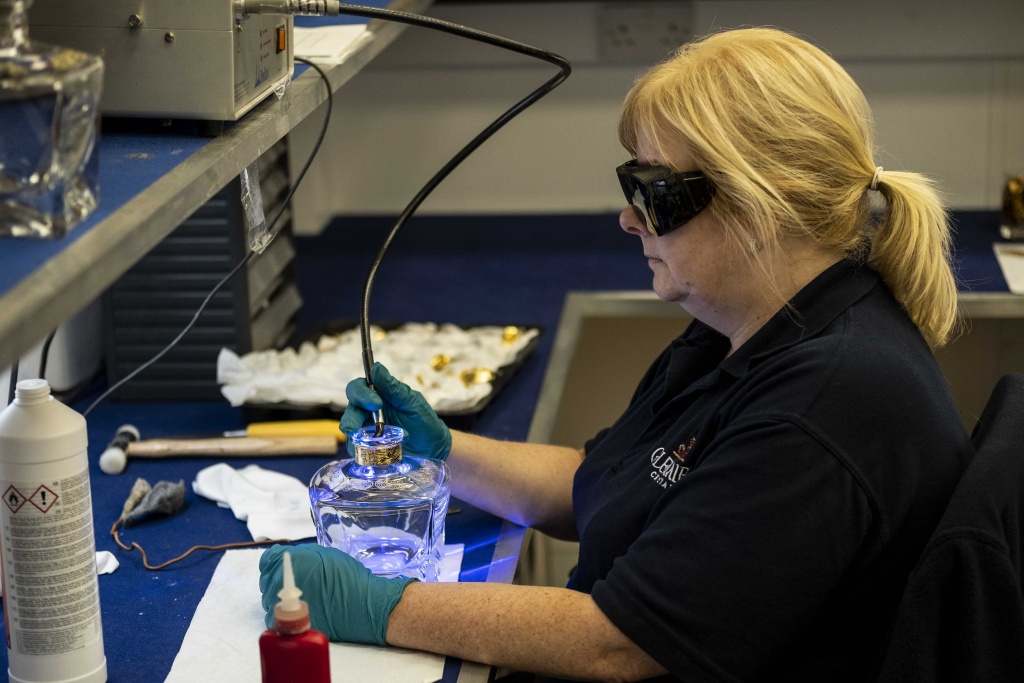 What’s your favourite piece in the collection?
I have a reference sample of a johnnie walker bottle that’s engraved, presented from Paul Walsh and Ivan Menezes. It’s a personal engraved gift from them and they’re the old and new CEO of Diageo.
You’ve created the iconic, eponymous Glencairn glass. What design aspirations do you have for the future?
We want to try and predict, what’s the next wine glass? What’s the next innovative shape and execution of it that looks really funky, and people will aspire to have it? Ultimately, we hope that the designs features of what we create here will feed back into other products.
What’s your favourite piece in the collection?
I have a reference sample of a johnnie walker bottle that’s engraved, presented from Paul Walsh and Ivan Menezes. It’s a personal engraved gift from them and they’re the old and new CEO of Diageo.
You’ve created the iconic, eponymous Glencairn glass. What design aspirations do you have for the future?
We want to try and predict, what’s the next wine glass? What’s the next innovative shape and execution of it that looks really funky, and people will aspire to have it? Ultimately, we hope that the designs features of what we create here will feed back into other products.
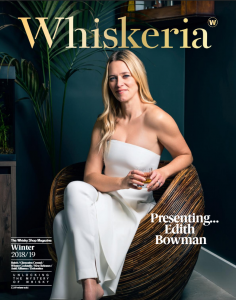 The original feature is our cover story in the Winter 2018 edition of Whiskeria, delivered to the door of W Club subscribers and also free with any Whisky Shop purchase in store or online. Learn more here.
The original feature is our cover story in the Winter 2018 edition of Whiskeria, delivered to the door of W Club subscribers and also free with any Whisky Shop purchase in store or online. Learn more here. 4.7/5 with 10,000+ reviews
4.7/5 with 10,000+ reviews